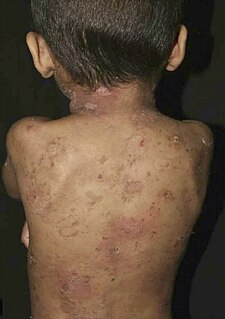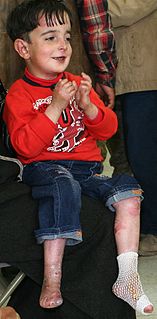Related Research Articles

A blister is a small pocket of body fluid within the upper layers of the skin, usually caused by forceful rubbing (friction), burning, freezing, chemical exposure or infection. Most blisters are filled with a clear fluid, either serum or plasma. However, blisters can be filled with blood or with pus.

Epidermolytic ichthyosis (EI), also known as bullous epidermis ichthyosis (BEI), epidermolytic hyperkeratosis (EHK), bullous congenital ichthyosiform erythroderma (BCIE), bullous ichthyosiform erythroderma or bullous congenital ichthyosiform erythroderma Brocq, is a rare and severe form of ichthyosis this skin disease affects around 1 in 300,000 people.

Epidermolysis bullosa (EB) is a group of rare medical conditions that result in easy blistering of the skin and mucous membranes. Blisters occur with minor trauma or friction and are painful. Its severity can range from mild to fatal. Those with mild cases may not develop symptoms until they start to crawl or walk. Complications may include esophageal narrowing, squamous cell skin cancer, and the need for amputations.

Keratin 14 is a member of the type I keratin family of intermediate filament proteins. Keratin 14 was the first type I keratin sequence determined. Keratin 14 is also known as cytokeratin-14 (CK-14) or keratin-14 (KRT14). In humans it is encoded by the KRT14 gene.

Hemidesmosomes are very small stud-like structures found in keratinocytes of the epidermis of skin that attach to the extracellular matrix. They are similar in form to desmosomes when visualized by electron microscopy, however, desmosomes attach to adjacent cells. Hemidesmosomes are also comparable to focal adhesions, as they both attach cells to the extracellular matrix. Instead of desmogleins and desmocollins in the extracellular space, hemidesmosomes utilize integrins. Hemidesmosomes are found in epithelial cells connecting the basal epithelial cells to the lamina lucida, which is part of the basal lamina. Hemidesmosomes are also involved in signaling pathways, such as keratinocyte migration or carcinoma cell intrusion.

DEBRA is the name of an international medical research charity dedicated to the curing of epidermolysis bullosa, with national groups in over 40 countries and growing.

Epidermolysis bullosa simplex (EBS), is a disorder resulting from mutations in the genes encoding keratin 5 or keratin 14.

Kindler syndrome is a rare congenital disease of the skin caused by a mutation in the KIND1 gene.

Keratin 5, also known as KRT5, K5, or CK5, is a protein that is encoded in humans by the KRT5 gene. It dimerizes with keratin 14 and forms the intermediate filaments (IF) that make up the cytoskeleton of basal epithelial cells. This protein is involved in several diseases including epidermolysis bullosa simplex and breast and lung cancers.

Junctional epidermolysis bullosa (JEB) is an inherited disorder that is also known as red foot disease or hairless foal syndrome. JEB is the result of a genetic mutation that inhibits protein production that is essential for skin adhesion. Therefore, tissues, such as skin and mouth epithelia, are affected. Blisters form over the entire body causing pain and discomfort,and open sores leave newborn foals highly susceptible to secondary infection. The condition can be categorized into two types of mutations: JEB1 and JEB2. JEB1 is found in Belgian Draft horses, as well as other related Draft breeds. In contrast, JEB2 is found in American Saddlebred horses.

Collagen XVII, previously called BP180, is a transmembrane protein which plays a critical role in maintaining the linkage between the intracellular and the extracellular structural elements involved in epidermal adhesion, identified by Diaz and colleagues in 1990.
Epidermolysis bullosa dystrophica or dystrophic EB (DEB) is an inherited disease affecting the skin and other organs.

Genodermatosis is a hereditary skin disease with three inherited modes including single gene inheritance, multiple gene inheritance and chromosome inheritance. There are many different types of genodermatosis, the prevalence of genodermatosis ranges from 1 per 6000 people to 1 per 500,000 people. Genodermatosis has influence on the texture, color and structure of skin cuticle and connective tissue, specific lesion site and clinical manifestations on the body vary depending on the type. In the spite of the variety and complexity of genodermatosis, there are still some common methods that can help people diagnose. After diagnosis, different types of genodermatosis require different levels of therapy including interventions, nursing interventions and treatments. Among that, research of therapy for some new, complex and rare types are still in the developing stage. The impact of genodermatosis not only can be seen in body but also can be seen in all aspects of patients’ life, including but not limited to psychological, family life, economic conditions and social activities. Accordingly, the patients need treatment, support and help in these areas.

Collagen alpha-1(VII) chain is a protein that in humans is encoded by the COL7A1 gene.
Anchoring fibrils extend from the basal lamina of epithelial cells and attach to the lamina reticularis by wrapping around the reticular fiber bundles. The basal lamina and lamina reticularis together make up the basement membrane. Anchoring fibrils are essential to the functional integrity of the dermoepidermal junction.

Ichthyosis bullosa of Siemens is a type of familial, autosomal dominant ichthyosis, a rare skin disorder. It is also known as bullous congenital ichthyosiform erythroderma of Siemens or ichthyosis exfoliativa. It is a genetic disorder with no known cure which is estimated to affect about 1 in 500,000 people.
Junctional epidermolysis bullosa is a skin condition characterized by blister formation within the lamina lucida of the basement membrane zone.
Lethal acantholytic epidermolysis bullosa is a fatal genetic skin disorder caused by mutations in DSP

Ken Hashimoto was a Japanese professor of dermatology resident in the United States, who pioneered research in skin disease using electron microscopy and histochemistry.
References
- ↑ James, William; Berger, Timothy; Elston, Dirk (2005). Andrews' Diseases of the Skin: Clinical Dermatology. (10th ed.). Saunders. ISBN 0-7216-2921-0.
- ↑ Bardhan, Ajoy; Bruckner-Tuderman, Leena; Chapple, Iain L. C.; Fine, Jo-David; Harper, Natasha; Has, Cristina; Magin, Thomas M.; Marinkovich, M. Peter; Marshall, John F.; McGrath, John A.; Mellerio, Jemima E. (2020-09-24). "Epidermolysis bullosa". Nature Reviews Disease Primers. 6 (1): 78. doi:10.1038/s41572-020-0210-0. ISSN 2056-676X. PMID 32973163. S2CID 221861310.
- 1 2 "Transient bullous dermolysis of the newborn | Genetic and Rare Diseases Information Center (GARD) – an NCATS Program". rarediseases.info.nih.gov. Retrieved 11 August 2018.
- ↑ Hammami-Hauasli N, Raghunath M, Küster W, Bruckner-Tuderman L (December 1998). "Transient bullous dermolysis of the newborn associated with compound heterozygosity for recessive and dominant COL7A1 mutations". J. Invest. Dermatol. 111 (6): 1214–9. doi:10.1046/j.1523-1747.1998.00394.x. PMID 9856844.
- ↑ John Thorne Crissey; Lawrence C. Parish; Karl Holubar (2013). Historical Atlas of Dermatology and Dermatologists. CRC Press. p. 179. ISBN 978-1-84214-100-7.
- ↑ Murase, K; Kanoh, H; Ishii, N; Hashimoto, T; Nakano, H; Sawamura, D; Seishima, M (2011). "Bullous Dermolysis of the Newborn and Dystrophic Epidermolysis Bullosa Pruriginosa within the Same Family: Two Phenotypes Associated with a COL7A1 Mutation". Acta Dermato Venereologica. 91 (6): 730–731. doi: 10.2340/00015555-1154 . ISSN 0001-5555. PMID 21629976.